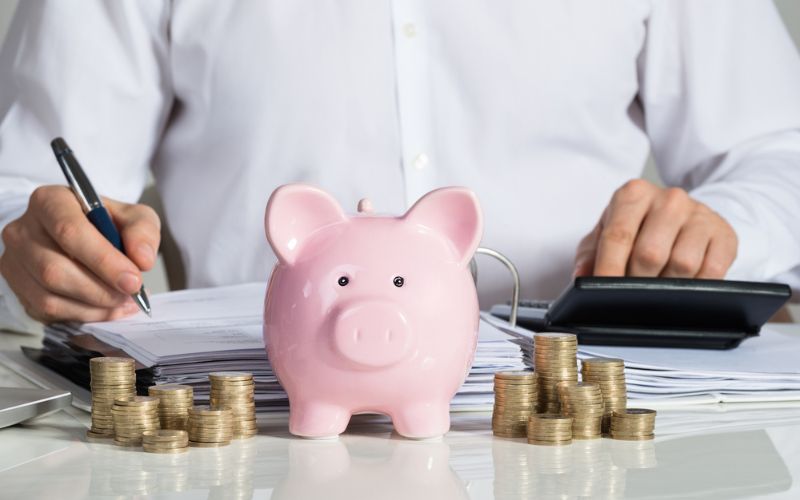If you’ve been struggling to save money to put towards a down payment on a house, you’re not alone. With mortgage rates and the prices of homes skyrocketing all across the country, it’s not uncommon for first-time home buyers to borrow or be gifted a down payment from other sources, particularly their parents. Although there are other means of borrowing a down payment, such as a line of credit, a personal loan, or tapping into your savings, there’s no doubt that saving thousands of dollars yourself is both rewarding and tough.
The trouble is …
Where do you even start?
Here are some tips that can help you save for a down payment so you can buy a home and finally dip your toes in the waters of real estate.
Top six ways to start saving for a down payment so you can buy a house

It’s time to start saving and here’s what you can do to make your down payment and closing costs saving process even easier:
1. Open a savings account
Having a savings account can be one of the best ways to put money aside and not end up touching it so it continues to increase, and even build a little bit of interest. It’s also really convenient and requires no extra work on your end. All you need to do is tell your financial institution that you want to open a traditional savings account and set up auto-deposit so that every time you get paid, for example, a set amount will automatically be transferred into the savings account.
You can also start a Registered Retirement Savings Account (RRSP) and use up to $35,000 of your savings ($70,000 as a couple) to buy your first home along with the federal government’s Home Buyers’ Plan. However, you must repay that amount back to your retirement savings within the next 15 years.
2. When do you want to buy a house?
Coming up with a timeframe on when you actually want to start the home buying process can help you stay on track and help you make sure you’re setting aside the proper amount of money every month, especially if you have a general idea of where you’re hoping to buy a house. Knowing the when and where aspects will definitely aid in the process of figuring out how much you’ll (approximately) need to save.
3. Prioritize your goals
If owning a home is your ultimate goal, you may need to put other things on the back burner for now such as buying a new car, going on vacation (sorry!), limiting how often you go out to eat, or resisting purchasing that nice watch on display. It may not seem like a big deal at the time, but every little bit you put towards a down payment can really come in handy in the end, even if it is only $50.
4. Pay off your debts
This obviously sounds a lot easier said than done, but trying to pay off other debts (like your credit card) first can actually help improve your chances of getting improved for the mortgage amount you want. The debt-to-income ratio is one of the most important factors when it comes to determining how much mortgage you’ll be able to borrow, particularly when it comes to your credit score. How long you’ve been building credit, how often you make payments on your credit card, any outstanding line of credits, and if your payments are made on time will all be taken into consideration. A credit score of 660 and up is considered good. A bad credit score is 579 and below. The lower your credit score is, the more you’ll be deemed a “risky” lender.

5. Put yourself on a strict budget
Buying a home comes with sacrifices. Remember, you want your saving account to increase, not decrease! This means you may have to get used to living on a stricter budget. Ways to do this can include:
- Think before you buy. Get into the mindset of: is it a want, or a need?
- Skip vacations for a bit, try to find the best deals available, or vacation locally
- Try not to eat out a lot and if you do, use coupons Go to the library instead of buying books
- Buy used clothes or stick to your current wardrobe
- When grocery shopping, make a list and stick to it (and use as many coupons as you can)
- Research prices before you go somewhere and see if they offer price matches
6. Work on the side, if you can
Working full-time is already tough enough, but some people may find it beneficial to get a temporary part-time job on the side as well to make saving a little easier. Or, if you have a hobby like painting, pottery, or making jewellery, consider selling your products online. Remember, any contribution can make a huge difference, even if it seems small at first. Plus, you can take advantage of an extra job to help pay off your debts quicker.
How else to come up with a down payment so you can get into your first home
If saving every month has proven to be difficult (which it is for many of us, especially while renting or paying for a car), there are other means by which you can borrow a down payment, or utilize government programs.
Home Buyers’ Plan
As mentioned above, you can tap into your RRSP account to withdraw up to $35,000 tax-free (or $70,000 as a couple). This does, however, require repayments for the next 15 years.
First-Time Home Buyer Incentive
The First-Time Home Buyer incentive is shared equity with the Government of Canada. If you qualify, the incentive aims to help reduce monthly mortgage payments by five to 10 per cent on a newly constructed home, five per cent on a resale home, and five per cent on new or resale mobile or manufactured homes. This allows first-timers to potentially save less for a down payment since their monthly mortgage payments will be less as well. The buyers must repay the incentive in 25 years or when the home is sold, but they can also choose to pay the incentive back in full when they require the funds without penalty.
First-Time Home Buyers’ Tax Credit
While this isn’t necessarily a way to save for a down payment, it is a way to get money back from the government for future mortgage payments or just help you financially in general. Those who are just purchasing a home for the first time (or who haven’t owned a home in the last four years) will qualify and can receive a total tax rebate of $750. This may not sound like a lot, but when you’re purchasing a new home, any amount of money helps.
GST/HST New Housing Rebate
This is another rebate program that you can obtain the GST/HST portion of what you paid on an owner-built home, purchased a new residential rental property, or have undergone a substantial renovation/home addition. You can receive a maximum amount of $30,000 if you qualify.

How much you may need to save before buying a house, including closing costs
Even if it takes you a few years to save the amount needed to buy a house, starting to save early can make all the difference in the world. In Canada, the typical amount you need to save for a down payment is five per cent on the first $500,000, and 10 per cent on the remaining amount, so, for example, if a house is listed at $600,000, you’ll need $35,000 as a down payment. This amount doesn’t include closing costs though, which can run anywhere from another two to four per cent of the purchase price. In that case, if a home is $600,000, closing costs could range from $12,000-$24,000.
A common mistake first-time buyers make before buying a home is just saving enough for a down payment, therefore, you’ll also want to consider saving for the following* before looking for a new home:
* These are rough cost estimates and are subject to change.
Property Appraisal ($300+)
A real estate appraisal, or land valuation, is when an expert determines the value of a home before it’s listed on the market. A value is determined based on what other properties are selling for in the area, current market trends, and the aspects of the home (square footage, upgrades, etc.). This can help sellers determine if they’re happy with the value or if they need to improve on finishing touches before listing to get the most ROI.
Home Inspection ($300+)
A home inspector provides a close search of the home, not the whole property like an appraiser. They’ll ensure that things are up to code and safe such as the framework, electrical work, plumbing work, the roof, the exterior, and more.
Title Insurance ($400+)![]()
Title insurance is necessary as it protects you if there are any issues with signing over ownership to the house, and losses due to title fraud/defects. Title insurance isn’t actually mandatory, however, it’s definitely recommended to protect you against any potential risks, for example, if the seller puts the house for sale without their ex-partner knowing and that partner tries to dispute the sale, leaving you without a home.
Mortgage Insurance
Mortgage insurance doesn’t necessarily benefit homeowners in big ways unless they’re seen as a risky lender. These rates will vary and will be calculated at a certain percent of the purchase cost. It’s mainly to assist the financial lender in case you default on a mortgage payment. The cost will be added to your monthly mortgage payments.
Land Transfer Taxes
Whether you buy a condo or a house, every property is subject to land transfer taxes in Ontario. The cost will vary per transaction depending on the province and will be paid when the deed to the house is transferred in your name. The cost will be calculated after taking into consideration the province, the purchase price, the cost of upgrades, and more.
Legal Costs ($500+)
You’ll need to pay your lawyer for conducting a title search, prepare and review the deed and any other paperwork, transferring documents, etc. It’s not legally required, but it does make the process much easier, especially for those who have never gone through the buying or selling process before.
Moving Expenses ($750+)
Don’t forget you’ll likely have to pay for a moving truck! They typically charge per hour and also take into consideration the distance between your current living situation and your newly purchased home. If you know a few people with trucks that are willing to help, great! Otherwise, you’ll want to invest in a professional moving company.
Property Taxes ($1,000+)
Just like when you rent and provide the landlord with last month’s rent, you’ll have to reimburse the seller’s property taxes, utility charges and other expenses. Your lawyer will be able to determine how much you’ll owe, which will be paid on the closing day. Remember, this is only if the seller has pre-paid for the entire year, otherwise, they will have to make a payment to the municipality.
Struggling to save for a down payment?
If you’re struggling to pay for a down payment, you’re not alone. It’s not uncommon for people just getting into the real estate world to borrow a down payment from a family member or a different financial lender than their mortgage is from. Saving for a down payment can definitely take longer than you’d hope, but there are still ways you can reach your goal of doing it yourself!
The best way to save for a down payment is to free yourself of debt and other expenses, particularly a car or a credit card. You should also consider making a plan/a goal; when do you actually see yourself moving into a home? One year from now? Two years from now? Once you have a goal in mind, this can help you determine a proper savings plan. You’ll also find it beneficial to set up a savings account with automated payments, so every time you get paid, money will automatically be transferred into your savings. You could save even more money if you stuck to a strict budget; no more going out for dinner or splurging on newly released books or movies!
Lastly, remember that when it comes to your savings for a house, a down payment isn’t the only expense. Expenses associated with closing on a house can be quite extensive, especially when it comes to appraisals, land transfer taxes, property taxes, moving costs, and lawyer fees. While you shouldn’t let this damper your plan to get into real estate, you should definitely take the time to map out realistic goals according to your specific financial situation. Take it step-by-step. This isn’t something that everyone can rush into, and that’s okay.
</class=center”>


